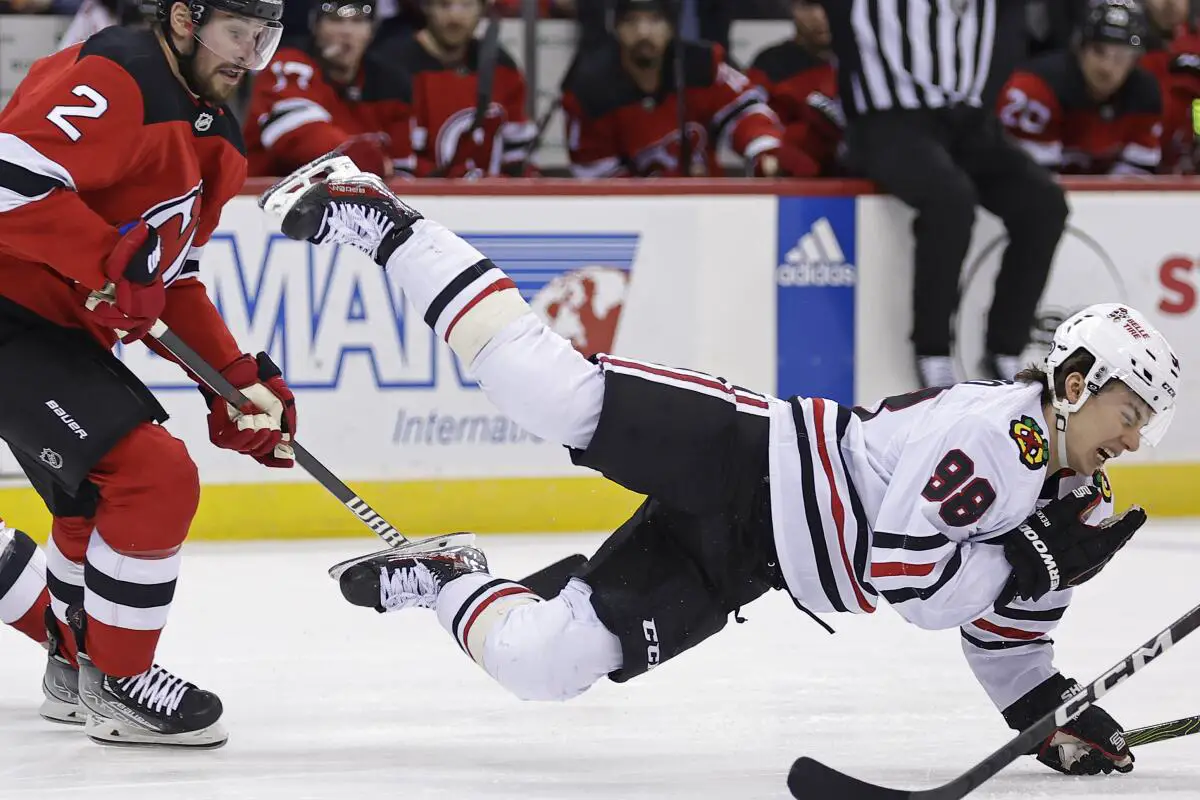Hockey players typically rest between shifts for about 30-60 seconds to manage player fatigue. In professional hockey, managing player fatigue is essential for optimal performance and preventing injuries.
The rest between shifts, typically lasting 30-60 seconds, allows players to recover and maintain their stamina throughout the game. Understanding the importance of strategic rest periods and efficient energy management can significantly impact a team’s success on the ice. Players must balance high-intensity play with effective recovery to ensure they can consistently perform at their best.
Implementing effective rest strategies is crucial for sustaining energy levels and maximizing performance during gameplay. Understanding how managing player fatigue contributes to overall team success is a critical aspect of professional hockey.

Credit: www.sandiegouniontribune.com
Table of Contents
- 1 Understanding Player Fatigue In Hockey
- 2 Strategies For Managing Player Fatigue
- 3 Enhancing Performance Through Improved Recovery
- 4 Insights Into Managing Shifts In Hockey
- 5 Combatting Fatigue With Proper Training
- 6 Frequently Asked Questions Of How Long Do Hockey Players Rest Between Shifts? Managing Player Fatigue
- 7 Conclusion
Understanding Player Fatigue In Hockey
As hockey players engage in relentless shifts on the ice, understanding player fatigue becomes crucial for managing their performance. The intensity of the game and the physical exertion involved can lead to a decrease in energy levels, impacting both individual players and the overall team performance. By delving into the factors that contribute to player fatigue, teams can effectively manage and optimize player rest periods between shifts.
The Impact Of Muscle Acidity On Fatigue
Muscle acidity plays a significant role in causing fatigue and soreness among hockey players. During intense physical activity, glucose is converted into energy within the muscles, resulting in the production of lactic acid. This lactic acid then breaks down into lactate and hydrogen ions. The accumulation of hydrogen ions in the muscles increases their acidity, which is a primary contributor to fatigue and soreness.
To combat muscle acidity and reduce fatigue, players must focus on recovery strategies that help clear lactate and hydrogen ions from their muscles. Proper rest periods between shifts allow the muscles to recover, eliminating excess acidity and minimizing fatigue. By managing these rest periods effectively, teams can optimize player performance and reduce the risk of long-term fatigue-related injuries.
Importance Of Proper Hydration In Managing Fatigue
Proper hydration is vital in managing player fatigue during hockey games. Inadequate fluid intake can accelerate overall fatigue and heat stress, negatively impacting performance. As body temperature increases, fatigue increases, and the risk of illness also rises.
During practices and games, players must prioritize drinking plenty of water or sports drinks. These fluids replenish the body’s electrolytes and keep players hydrated, reducing the risk of fatigue. Adequate hydration not only helps players maintain performance but also enhances recovery between shifts.
In addition to proper hydration, players should opt for nutrient-dense snacks that provide lasting sustenance. Energy bars, nuts, and fruits are excellent choices for quick-energy snacks, keeping energy levels high and supporting optimal performance throughout the game. Avoiding sugary snacks is essential as they can cause a rapid energy spike followed by a crash, impacting performance and increasing fatigue.
In conclusion, understanding player fatigue in hockey is crucial for optimizing player performance and reducing the risk of long-term fatigue-related injuries. By addressing factors such as muscle acidity and proper hydration, teams can effectively manage rest periods between shifts, ultimately enhancing player performance and contributing to overall team success.

Credit: theathletic.com
Strategies For Managing Player Fatigue
Managing player fatigue is crucial in hockey as it directly impacts performance and injury risk. Understanding optimal rest periods between shifts and effective snacking for sustained energy levels can significantly enhance a player’s endurance on the ice.
Optimal Rest Periods Between Shifts
Effective rest periods between shifts play a pivotal role in managing player fatigue. Research has shown that shorter shifts of 30-45 seconds followed by adequate rest periods of 1.5-2 minutes can optimize player performance and reduce exhaustion during games.
Effective Snacking For Sustained Energy Levels
Proper nutrition is essential for maintaining energy levels during intense hockey games. Choosing nutrient-dense snacks such as energy bars, nuts, and fruits can provide sustained energy, helping players avoid rapid fatigue. Moreover, avoidance of sugary snacks is advised, as they can lead to energy crashes and decreased performance.
Enhancing Performance Through Improved Recovery
Enhancing performance through improved recovery is crucial for managing player fatigue in hockey. Rest periods between shifts play a key role in optimizing player performance by allowing them to recover and maintain peak physical condition throughout the game. Effective rest strategies ensure players’ energy levels remain high, enhancing their on-ice capabilities and overall gameplay.
The key to enhanced performance on the ice lies in maximizing recovery between shifts to combat fatigue and improve overall endurance. Hockey players can significantly boost their on-ice performance by increasing lung capacity and adhering to a tailored nutritional plan. Here’s how to optimize recovery and elevate your game.Increasing Lung Capacity For Improved Endurance
Enhancing lung capacity directly translates to improved endurance and stamina on the ice. Deep breathing exercises, such as diaphragmatic breathing, can help increase oxygen intake and improve overall lung function. Additionally, incorporating aerobic exercises like running and cycling into your training regimen can bolster lung capacity, leading to better performance during high-intensity shifts.Nutritional Tips For Hockey Players
Proper nutrition plays a pivotal role in managing fatigue and maximizing recovery between shifts. Opt for nutrient-dense snacks like energy bars, nuts, and fruits to sustain energy levels throughout the game. Ensure adequate hydration by consuming water or sports drinks to prevent dehydration, fatigue, and heat stress. A balanced diet comprising lean proteins, complex carbohydrates, and healthy fats is essential for replenishing energy stores and supporting optimal performance on the ice.Insights Into Managing Shifts In Hockey
Discover the key insights into managing shifts in hockey, specifically focusing on how long hockey players rest between shifts and effectively managing player fatigue. Understanding the factors that contribute to fatigue can help optimize player performance on the ice.
Shift Lengths In Hockey Games
In hockey games, shifts are the periods of time when players are on the ice and actively participating in gameplay. The length of shifts in hockey can vary depending on several factors, including player fatigue, game situation, and coaching strategy.
On average, shifts in hockey games tend to last between 30 to 60 seconds for forwards and 45 to 90 seconds for defensemen. These durations allow players to exert maximum effort during their time on the ice, as the fast-paced nature of the sport requires frequent bursts of energy.
Shorter shifts allow players to maintain high-speed intensity and agility, while longer shifts may be reserved for powerplays or when players are in exceptional physical condition. Coaches carefully manage shift lengths to prevent player fatigue and ensure optimal performance throughout the game.
Factors Influencing Line Changes In Nhl
In the National Hockey League (NHL), several factors influence line changes – the substitution of players on the ice. Line changes are implemented strategically to maintain player energy levels, exploit opponent weaknesses, and adapt to different game scenarios.
Here are some factors that influence line changes in the NHL:
- Player Fatigue: Preserving player energy is crucial in hockey. Coaches make line changes to prevent players from becoming excessively tired, thus maintaining their speed and agility on the ice.
- Matchups: Coaches make line changes to create favorable matchups against specific opponents. Certain lines may be better suited to defend against or exploit the strengths and weaknesses of opposing players or lines.
- Injury or Penalty: Line changes may be necessary when a player is injured or serving a penalty. Coaches must quickly adjust to maintain a balanced and effective lineup.
- Game Situation: Line changes vary depending on the score, time remaining, and game strategy. For example, during the final minutes of a close game, coaches may shorten shift lengths to keep fresh and highly skilled players on the ice.
Effective management of line changes is critical in maintaining player fatigue levels and optimizing team performance in hockey games.
Combatting Fatigue With Proper Training
Proper training is key in combatting fatigue for hockey players. Managing player fatigue involves strategic rest periods between shifts to optimize performance and prevent exhaustion on the ice. By implementing effective training methods and ensuring adequate downtime between shifts, players can maintain energy levels and improve overall game performance.
Understanding Shift Length Recommendations
Hockey players often wonder about the optimal shift length to prevent fatigue and maintain peak performance on the ice. According to experts, the recommended duration for a shift in hockey typically falls within the range of 30 seconds to 2 minutes. Exceeding this recommended time frame can lead to increased fatigue, decreased energy levels, and potential performance decline.
Key Considerations For Avoiding Fatigue In Hockey Players
Proper training plays a crucial role in combatting fatigue among hockey players. By focusing on key considerations such as endurance, strength, and recovery, coaches and athletes can effectively manage player fatigue and optimize performance during games. Implementing structured training programs that emphasize conditioning, stamina building, and rest intervals can significantly enhance player resilience and minimize the risk of exhaustion during gameplay.
- Ensure adequate rest periods between shifts
- Implement conditioning drills to improve endurance
- Incorporate strength training to support muscle function
- Emphasize proper nutrition and hydration for sustained energy

Credit: hockeytraining.com
Frequently Asked Questions Of How Long Do Hockey Players Rest Between Shifts? Managing Player Fatigue
Why Do Hockey Players Get Tired So Fast?
Hockey players get tired fast due to the build-up of lactic acid in their muscles, leading to increased acidity and fatigue. This process is caused by the conversion of glucose to energy during muscle exertion. Adequate hydration and smart snacking can help maintain energy levels during intense games.
How Do You Get Less Tired In Hockey?
To reduce fatigue in hockey, stay hydrated by drinking water or sports drinks during games and practices. Snack on easily digestible and quick-energy foods like energy bars, nuts, and fruits to maintain energy levels. Avoid sugary snacks and opt for nutrient-dense choices.
Additionally, focus on proper breathing techniques to optimize oxygen intake and improve alertness and decision-making.
How Can I Increase My Lung Capacity For Hockey?
To increase lung capacity for hockey, focus on cardiovascular exercises like running, cycling, and swimming. Breath control drills and proper hydration also help enhance endurance on the ice.
How Do You Preserve Energy In Hockey?
To preserve energy in hockey, opt for quick-energy snacks like energy bars, nuts, and fruits during games. Avoid sugary snacks and choose nutrient-dense options for lasting sustenance throughout the intense periods of play. Proper hydration and smart snacking can help maintain energy levels and performance on the ice.
Conclusion
In hockey, managing player fatigue is crucial to optimize performance on the ice. Understanding how long hockey players rest between shifts is key to this management. It is important to strike a balance between allowing players enough time to recover and ensuring they maintain their energy levels throughout the game.
By implementing smart snacking, staying hydrated, and focusing on breathing techniques, players can minimize fatigue and make smarter decisions on the ice. Remember, more oxygen means less fatigue and more alertness. So, take the time to rest, refuel, and strategize for a winning game.
